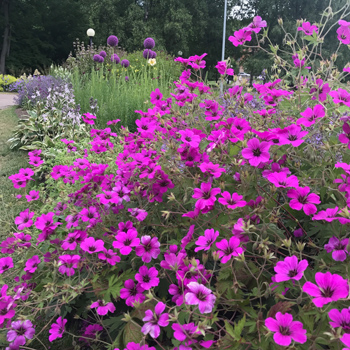by Roger L. VanNostrand

An island bed in full bloom
Attractive, low-maintenance island plantings set in front and back lawn areas are becoming very popular in both new and older home landscapes.
Historically, massive plantings were installed to hide unattractive high foundations built to accommodate full basements. Many homes now either are built on concrete slabs, over crawl spaces with low foundations, or over full basements with attractive siding or stone facings that really don’t need plantings to hide them.
Plantings off corners of the house can help to soften the vertical lines, hide down spouts, meters, air conditioners, and generators, but otherwise there is little need to make expensive, high maintenance plantings that can grow to hide windows, rub against siding, and spread over walkways. In many cases such plantings are seen from indoors only by pressing one’s nose against a window.
An attractive, practical, low cost, low maintenance alternative for any style home is the island bed—planted where it can be enjoyed out the front, side, or back windows, and especially by visitors to your door.
By making the beds narrow, four to six feet wide, such plantings can feature dwarf shrubs or evergreens and a wonderful variety of colorful annuals and perennials. The tasteful addition of an interesting boulder or statuary, a birdhouse or feeder, or a water feature can bring such plantings to life all year ‘round. An advantage of a narrow bed is the ease of plantings maintenance. Since the plantings are surrounded by lawn grass, all plantings are within easy reach even after rainfalls and watering. The plants selected must be compact and limited to those that can be easily managed without severe pruning. Dwarf shrubs, alpines, rock garden plants, small edger plants and many succulents fit well in such gardens. “Compact” burning bushes, privets, hydrangeas, viburnums, yews, and most junipers and rhododendrons soon outgrow and crowd each other in narrow island beds.
By carefully selecting dwarf or slow growing compact plants, such gardens can be easily managed for many years. Start out with well-spaced perennials, some annuals in between, and two or three dwarf shrubs or evergreens. As your perennials become larger you may find that you will need fewer annuals, especially when you can divide your perennials and use them to fill in.
Use a garden hose to outline your island bed shape with gentle curves that can be easily followed with your mower. Locate dwarf shrubs or trees at either end where you can enlarge the bed to allow space for low growing edger plants. Experiment with various shapes, viewing them from indoors, the driveway, the street, and sidewalks until the size and shape seem appropriate. You might also place empty flowerpots inside the bed to get an idea of plant numbers and spacing.
After removing the lawn grasses (via digging or the lasagna method) and edging, incorporate generous amounts of screened topsoil and/or compost. This will elevate the bed for better drainage, make setting plants easy, and will display your plantings for full benefit.
By installing a modestly sized, well-designed island bed you will be able to enjoy your plants from indoors and out and provide an attractive welcome for visitors and passersby.
Roger VanNostrand is a former Cornell Cooperative Extension agent in Steuben and Chautauqua Counties and currently volunteers as an Extension Master Gardener in Ontario County. He is always happy to advise home gardeners and can be reached at (315) 462-2143.
Views: 1






